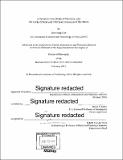A dynamo case study of Mercury, and the early orbital and thermal evolution of the Moon
Author(s)
Tian, ZhenLiang
DownloadFull printable version (10.39Mb)
Other Contributors
Massachusetts Institute of Technology. Department of Earth, Atmospheric, and Planetary Sciences.
Advisor
Maria T. Zuber.
Terms of use
Metadata
Show full item recordAbstract
Mercury's magnetic field is characterized by its weak strength, spin-aligned axisymmetry and a large offset of the magnetic equator relative to Mercury's geographic equator. The combination of these features is difficult to be explained with an Earth-like dynamo. We enhance the traditional dynamo model by adding a stably stratified layer in Mercury's core and a north-south asymmetric heat flux pattern at the core-mantle boundary, and find multiple cases in which the surface magnetic field exhibits all the observed characteristics. This result supports either thermal or chemical stratification at the top of Mercury's core, and suggests that the northern hemisphere mantle could be more convective, which could be caused by moderately elevated concentration of heat-producing elements in that region. The isotopic similarity between the Earth and Moon and the volatile depletion of the Moon collectively suggest the Moon-forming impact to have been a high-energy, high-angular momentum event. The excess angular momentum of the post-impact Earth-Moon system was suggested to have been drained through an orbital resonance mechanism. We find an alternative mechanism, a limit cycle, that can reduce angular momentum over a much broader parameter range. We couple the orbital evolution with lunar magma ocean solidification to assess the mutual effects of orbital processes and the Moon's thermal profile on each other. We find that the resonance is unstable for causing severe tidal heating in the Moon, while the limit cycle works with satisfaction in the coupled model. Consequently, the limit cycle is a more viable mechanism than the resonance to drain the excess angular momentum. Lunar volcanism is mainly concentrated in the lunar nearside. Researchers proposed that this hemispheric asymmetry could be the result of a single diaper ascension of deep, radiogenically heated material, but it is unclear why the diaper occurred in the nearside mantle. In an attempt to explain this observation by heterogeneous tidal heating, we computed the distribution of tidal heating in the lunar mantle, and find that tidal distortion is unable to concentrate heating and cause the diaper to occur in the lunar nearside when a spherically symmetric structure of the Moon is assumed.
Description
Thesis: Ph. D., Massachusetts Institute of Technology, Department of Earth, Atmospheric, and Planetary Sciences, February 2017. Cataloged from PDF version of thesis. Includes bibliographical references (pages 100-107).
Date issued
2017Department
Massachusetts Institute of Technology. Department of Earth, Atmospheric, and Planetary SciencesPublisher
Massachusetts Institute of Technology
Keywords
Earth, Atmospheric, and Planetary Sciences.